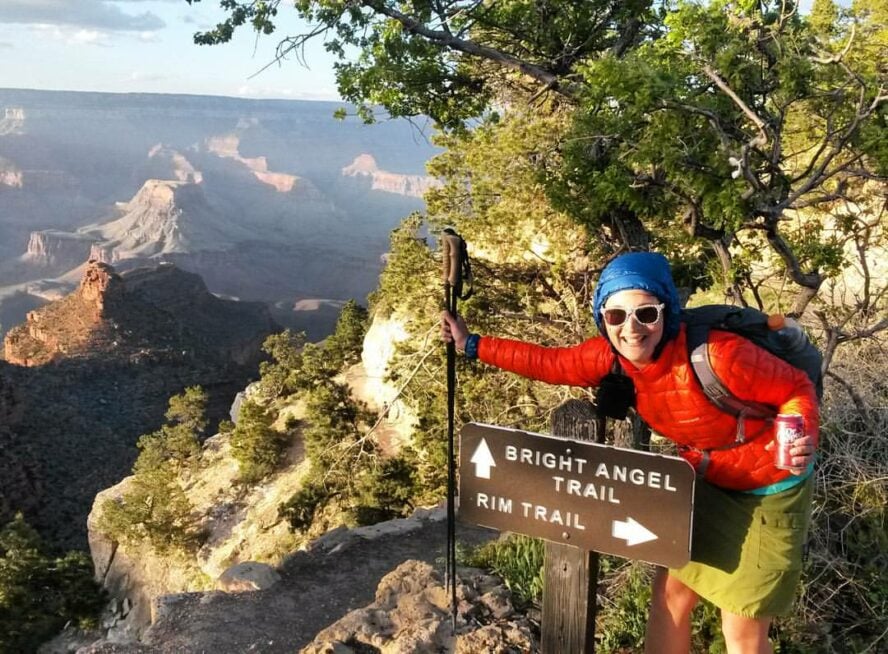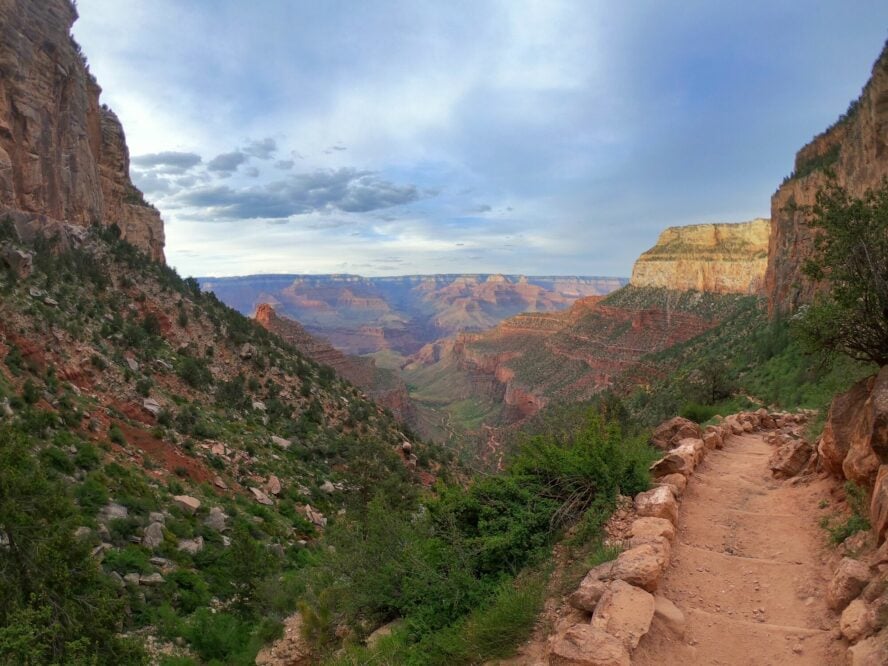Considered the premiere hike in the Grand Canyon, the Bright Angel Trail to Indian Garden is one of the most popular in the park. This 8.8 mile, 2,080 feet elevation gain out-and-back takes you past 2 billion years of geology and rock towers made of layers of red, rust, rose, and white.
The hike ends at a startlingly lush oasis of cottonwoods, willows, and grasses along a perennial stream. It’s a stark contrast to the grand towers of red desert rock you’ll see for your journey two-thirds of the way to the Colorado River.
A good option for an overnighter
While the descent is the easy part, the climb to get back to the trailhead is what most hikers find difficult. Before you go, check with rangers about conditions and (most importantly) whether the drinking fountains along the way are turned on. I recommend staying overnight on the Rim and starting pre-dawn or at sunrise because the ascent at the end is the hard part. You don’t want to be doing it during the hottest part of the day.
Indian Garden can be 20 degrees warmer than the Rim. This hike takes most people longer than they expect (budget twice the time to climb as to descend), so I’d suggest bringing a headlamp or flashlight so you don’t get stranded. Don’t let this scare you off, though— the Bright Angel Trail is considered to be the safest hike in the Grand Canyon.
Yield to oncoming mules
Start at the Bright Angel Trailhead (elevation 6,860 feet/2093 m) and descend down wide, well-maintained, well-marked switchbacks. This is the route used by the mule team that supplies Phantom Ranch at the bottom of the canyon, so they keep it in tip-top shape. Even with the (relatively) gradual descent, I like having trekking poles to help my knees.
Since there’s so much descending, I suggest making sure you have sturdy hiking shoes that are sized up. You won’t want your toes banging against the front of your shoes on this hike. You’ll also want to trim your toenails before this hike as long nails can dig into other toes when you’re descending this much. If you do run into the mule team, yield to them. The trail is plenty wide, except when you’re sharing it with a stock animal.

The first half mile can be full of canyon-gazers who can be slow to get out of the way. I’ve found that starting early, being patient, and asking groups to yield can help you navigate the crowds. As you descend, admire the layers upon layers of rock and the colossal cliffs in view. Even just half a mile in, the expansive panoramas of the canyon and surrounding rock are so much more up-close-and-personal when you walk into the canyon.
Top off your water bottle at Mile-and-A-Half Rest House
After 1.6 miles, you’ll reach the almost fittingly-named Mile-and-A-Half Rest House (5729 feet/1149 m). There’s a drinking fountain, toilet, and shade. Most hikers take a break here to cool off. During the busy season, there’s a ranger stationed here. On hot days (which tends to be most of the time), I’ll top off my water bottles here and soak my hat or shirt before continuing on. If the hike is getting to you, this makes a good turnaround point. You’ll have 1,100 feet of climbing from here back to the Rim.
At 3.1 miles in you reach the Three Mile Rest House (4748 ft/1149 m). Crowds drop off, though you’ll still see many other hikers taking a cool-off here. As at the other rest house, there’s a toilet. During peak season, there’s a running drinking fountain and ranger, too.

Indian Garden Camp
Finally, you’ll reach Indian Garden Camp at 4.4 miles in (3,800 ft/1160 m). If you make a reservation, you can camp here as part of a backpacking trip. Be sure to check the thermometer displayed here. I’m always surprised how much warmer it is at Indian Gardens than on the Rim. There’s a drinking fountain, clean toilets, picnic tables, a ranger station, and shade.
Indian Garden was home to the Havasupai people who lived in the canyon for thousands of years, drawn to the perennial water. They cultivated this site for crops — a literal garden. Archeological evidence near Indian Garden shows that the Ancestral Pueblans and prehistoric Cohonians lived here as early as AD 300.
Nearby are remnants of ten seasonal Pueblan structures. Although Theodore Roosevelt kicked out the Havasupai in 1903, the name remains (in part due to a private tourist resort called ‘Cameron’s Indian Garden Camp’). In 1923, the Park Service took over and began running the camp you see here today.


